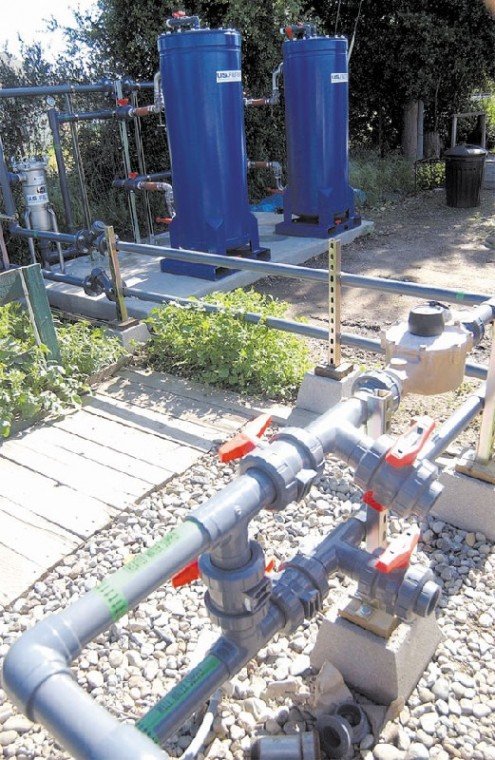Gilroy
– The state’s public health goal for perchlorate will not be
reopened for public comment and will likely not budge from its
current level of 6 parts per billion.
Gilroy – The state’s public health goal for perchlorate will not be reopened for public comment and will likely not budge from its current level of 6 parts per billion.
The Office of Environmental Health Hazard Assessment would not confirm that a final decision has been reached, but in a letter obtained by The Dispatch, OEHHA Director Joan Denton wrote that “we have concluded that new data are insufficient to support a reopening of the PHG … at this time.”
A public announcement is expected soon.
OEHHA’s decision to forego what could be a protracted and heated public comment period and not conduct or solicit additional scientific analysis of the contaminant’s health affects disappointed environmental and community activists who believe the goal should be set at 1ppb.
“Frankly, it’s appalling,” said Sujatha Jahagirdar of Environment California. “The idea that Cal EPA can be claiming to protect public health when ignoring the health of newborn infants is unacceptable.”
OEHHA is part of the state’s Environmental Protection Agency. In March 2004, the agency set the public health goal for perchlorate at 6 parts per billion and promised to reevaluate the standard once the National Academy of Sciences completed a review of the available data on perchlorate.
Released in January, the NAS report did not advocate a health goal or drinking water standard. It instead set a reference dose to determine an acceptable daily intake of perchlorate, a sodium compound used in the manufacture of rocket fuel and road flares that has been found to inhibit thyroid function.
Recent studies not considered by the NAS that have found perchlorate in lettuce, milk and breast milk suggest that perchlorate has entered the nation’s food supply, but in the letter, Denton said those studies are not enough to cause a reevaluation of OEHHA’s position.
“Without additional information,” she wrote, “this is still the most health-protective approach for infants.”
Sylvia Hamilton, chairwoman, of the Perchlorate Community Advisory Group, said she was not surprised by the decision. Hamilton wants OEHHA to lower the goal but said OEHHA’s decision brought a measure of relief.
“I think it’s too high, but on the other hand, it scares me to death that if they reopen it, it could go up,” Hamilton said. “I just want to be protective as possible. I’m hopeful that energy will remain on this issue and we’ll be able to gather more information about the levels at which perchlorate is or is not harmful. The more information we have, the better chance we have to get the level lowered.”
Confirming the public health goal allows another state agency, the Department of Health Services, to set a drinking water standard or maximum contaminant level. The DHS is expected to release that standard later this year. It cannot be lower than the health goal of 6 parts per billion.
The health goal and drinking water standard could have major consequences on the cleanup of perchlorate in San Martin and Morgan Hill. Perchlorate was discovered in 2000 at the site of a former road flare factory operated by Olin Corp., on Railroad Avenue in Morgan Hill. The plume has spread about 9.5 miles to the south and east of the site, contaminating more than 1,000 wells in the area.
In February, the Central Coast Regional Water Board ordered Olin to provide within one year a final cleanup plan for the wells and groundwater basin and indicate to what levels the water will be cleaned. The water board has ordered the company to clean the perchlorate to “background” levels, but Olin could use the health goal to argue that cleaning below that standard places an unnecessary financial burden on the company at no gain to the health of the community.
The company did just that in its so-far successful appeal of a regional board order to provide bottled water to San Martin residents whose wells test at or above 4 parts per billion. Last month, the State Water Control Board concluded that the regional board “abused its discretion” and should defer to the health goal.
In a written response to the state board’s order, the regional board declared that “if water replacement levels are required to be set at MCLs or PHGs, then it will be virtually impossible for the regional water boards to set groundwater cleanup levels at anything lower than the MCLs or PHGs.”
The regional board also argued that pumping contaminated wells could hinder cleanup of the groundwater.
The state board will hold a public hearing on its order Wednesday. In written comments to the state board, Olin suggested that the regional board’s water replacement order had “one true reason – to avoid local citizen controversy associated with withdrawing the delivery of no cost bottled water.”
Olin says it has spent $780,000 since March 12, 2004 providing water to the users of 566 wells that test below 6 parts per billion. Providing water only for those wells that test above 6 parts per billion and monitoring wells as low as 2 parts per billion, Olin says, will “fully protect the public.”
Regional board officials were not available Thursday, but their written argument contends that the “only appropriate course of action at this time is to be cautious on the side of people’s health.”
The regional board also frames the issue philosophically, arguing that it’s more appropriate to hold Olin to a trigger level below the health goal or maximum contaminant level.
In the brief, the regional board asks “why should a corporation that discharged illegally have the right to add [perchlorate] to an innocent well owner’s drinking water, right up to the public health level? We think it is much more appropriate to have a trigger concentration that is less than the absolute maximum allowed. … We think that scenario is very lenient towards the Discharger.”
The public hearing will be held 10am Wednesday, at 1001 I St., Sacramento. Speakers limited to three minutes. State board accepts written comments. For information contact Debbie Irvin at (916) 341-5600 or e-mail di****@************ca.gov. Environment California and Clean Water Action in San Francisco are planning a public rally in Sacramento that same day.
Next meeting
What: Meeting of the Perchlorate Community Advisory Group
When: Today, 2 to 4pm
Where: San Martin Lions Club, 12415 Murphy Ave.











